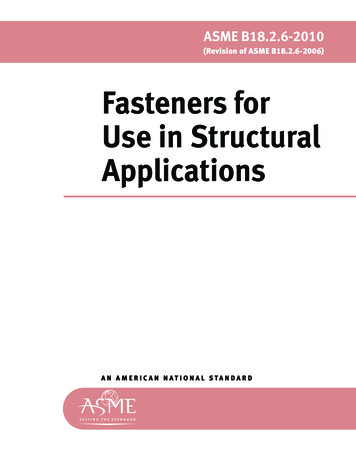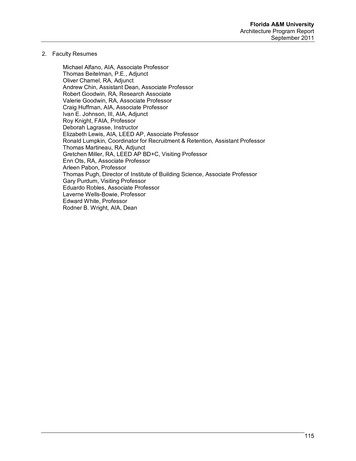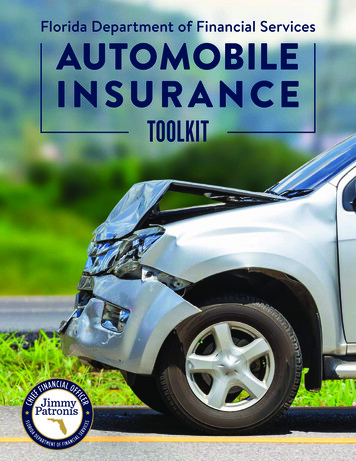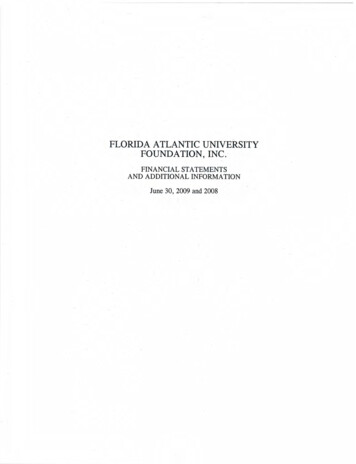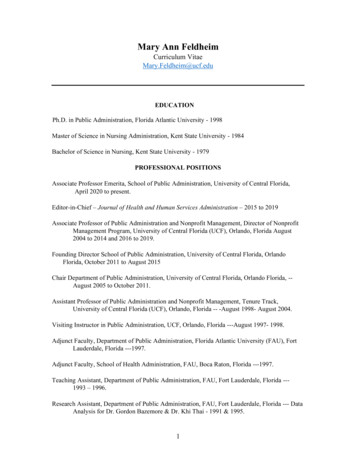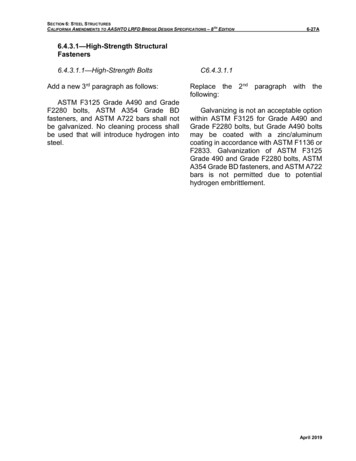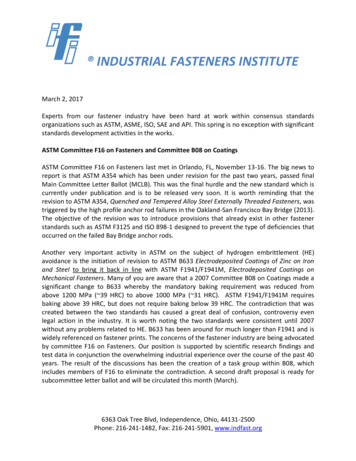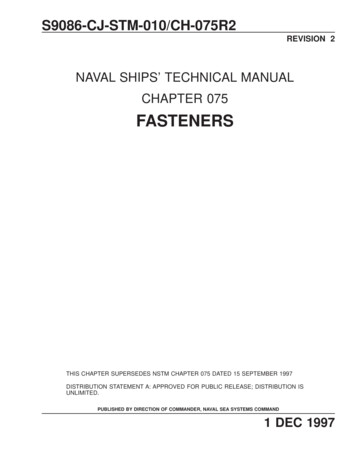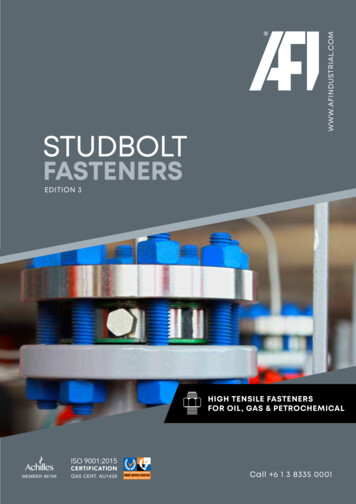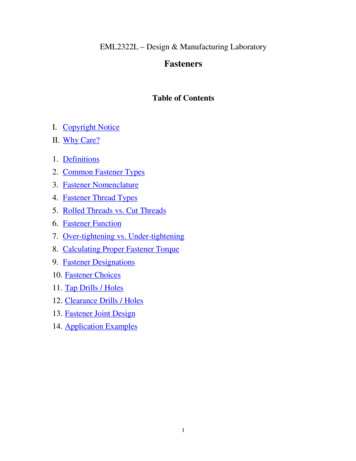
Transcription
EML2322L – Design & Manufacturing LaboratoryFastenersTable of ContentsI. Copyright NoticeII. Why Care?1. Definitions2. Common Fastener Types3. Fastener Nomenclature4. Fastener Thread Types5. Rolled Threads vs. Cut Threads6. Fastener Function7. Over-tightening vs. Under-tightening8. Calculating Proper Fastener Torque9. Fastener Designations10. Fastener Choices11. Tap Drills / Holes12. Clearance Drills / Holes13. Fastener Joint Design14. Application Examples1
Copyright notice: Much of the following material is taken from Carroll Smith’s Nuts, Bolts,Fasteners and Plumbing Handbook. This book contains a wealth ofknowledge concerning the proper selection and use of hardware used to joincomponents. It is available for 20 and will save you thousands of dollars inmistakes your first few years working industry. Translation: you would befoolish to perform mechanical design without reading a copy of this bookfrom cover to cover! These notes attempt to establish a solid foundation andprovide references for further study. Additional material and tables come from K. H. Moltrecht’s Machine ShopPractice and Joseph E. Shigley’s Mechanical Engineering Design textbooks.Why you should care about these notes: Fastener failures (due to improper design/selection or installation) are THENUMBER ONE cause of mechanical failures in industry. The topic is rarelygiven the focus it deserves in the classroom for a variety of reasons, none ofwhich are acceptable. Consequently, this will likely be the most thoroughdiscussion of fasteners you will receive. Virtually every mechanical assembly designed in industry makes use offasteners to attach components together to form systems.2
1. DefinitionsFasteners are defined as hardware that can be easily installed and removed with handor power tools. Common fasteners include screws, bolts, nuts and rivets. The termsbolts and screws do not refer to specific types of fasteners, but rather how they areused (i.e. the application). Thus the same fastener may be termed a bolt or a screw.Bolts are defined as headed fasteners having external threads that meet an exacting,uniform thread specification such that they can accept a non-tapered nut. Screws aredefined as headed, externally-threaded fasteners that do not mate with a non-taperednut and are instead threaded into the material they will hold. As shown in figure 1, abolt joint can be defined as that which uses a bolt and nut assembly (inherentlyrequiring two tools to tighten or loosen) whereas a screw joint can be defined as onein which a screw is mated into a matching female thread in a workpiece (thereforeonly requiring one tool to tighten or loosen). As seen in figure 1, studs are a hybridbetween a bolt and a screw, since one end of the stud functions as a screw while theother functions as a bolt. Figure 1. Bolt, screw and stud applications.2. Common Fastener TypesFigure 2 illustrates the variety of male fasteners used in industry; the most commontypes are hex head, slotted head, flat (or countersunk) head, round head, socket (or“allen”) head, button head and socket set screw. Figure 3 shows different femalefasteners (i.e. nuts) used in industry; the most common types are regular hexagonalnuts and nylon ring elastic stop nuts (also known as “lock nuts”).3
Figure 2. Male fasteners common in industry.4
Figure 3. Female fasteners common in industry.5
3. Fastener NomenclatureDesign engineers are frequently tasked with selecting and specifying fasteners used intheir designs. Consequently, understanding basic fastener nomenclature is important.Figure 4 illustrates the different parts of a standard threaded fastener.Figure 4. Important male fastener nomenclature.A. major diameter – the largest diameter of a fastener threadB. minor diameter – the smallest diameter of a fastener threadC. pitch – the linear distance from a point on the thread to a corresponding point on the nextthread – measured parallel to the axis of the threadD. lead – the linear distance that a point on a fastener thread will advance axially in onerevolution (equal to the pitch of the fastener)E. thread root – the surface of the thread that joins the flanks of adjacent threads and isimmediately adjacent to the cylinder from which the thread projects; in other words, thevalley of the thread.F. thread crest – the surface of the thread that joins the flanks of the thread and is farthestfrom the cylinder from which the thread projects; in other words, the peak of the thread.G. head – the enlarged shape that is formed on one end of the fastener to provide a bearingsurface and a method of turning (or holding) the fastenerH. bearing surface – the supporting surface of a fastener with respect to the part it fastens6
I. point – the extreme end of the threaded portion of a fastenerJ. shank – the cylindrical part of a fastener that extends from the underside of the head tothe starting threadK. length – the axial distance between the bearing surface of the head and the extreme pointL. grip length – the length of the unthreaded portion of the fastener (i.e. shank) measuredaxially from the underside of the bearing surface to the starting threadM. thread length – the length of the threaded portion of the fastener; NOTE: with allcommercial and aerospace fasteners, threaded length is a function of fastener diameter4. Fastener Thread TypesIn the most general sense, there are two classes of fastener threads: English andmetric. For each class, regardless of country of origin, there are two types of threads:fine thread and coarse thread. The drill and tap chart summarizes this information inone convenient location and will be referenced later in these notes.One of the most common fastener mistakes is using the wrong type of thread in thewrong type of material. The basic rule for fastener selection is: fine threads arestronger when the female thread is strong relative to the male thread, and coarsethreads are stronger when the female thread is weak relative to the male thread.The reason for this statement is that a smaller minor diameter increases the threadarea, resulting in higher static strength and fatigue resistance in female threads.Conversely, a larger minor diameter increases the stress area, resulting in a higherstatic strength and fatigue resistance in male threads. It is instructive to select afastener size off the tap chart and prove this statement; when performing the analysis,assume stresses are distributed over only the first five engaged threads.Figure 5 depicts a ¼-20 fastener. Due to the elasticity of the fastener, only the firstfive threads are engaged during loading regardless of the thread type (coarse / fine).Female threads typically fail due to shear along the major diameter and male threadstypically fail due to tensile loading along the thread root.7
Figure 5. Thread engagement and fastener failure.Since five threads carry the entire load regardless of thread type, a decrease in theminor diameter increases the shear area and gives an advantage to the female threadswhile reducing the load carrying capability of the male fastener. Conversely, anincrease in the minor diameter increases the male fastener’s cross-sectional area andgives an advantage to the male fastener, however, this reduces the shear area andweakens the female threads. Therefore, if the female fastener material is weakcompared to the male fastener material, the female fastener should be given theadvantage and coarse threads should be chosen. If the female fastener material isstrong compared to the male fastener material, the male fastener will always fail firstand should consequently be given the advantage by selecting fine threads.For this reason steel bolts and studs that thread into relatively weak aluminum or castiron castings such as engine blocks, cylinder heads and gearboxes are always coarsethreaded on the end that goes into the casting. Also invariably, the end of the stud thatreceives the nut is provided with a fine thread. In this way the designer ends up withthe best of both worlds.Because coarse threads are faster to assemble, they are often used in applicationswhere strength and weight are not of utmost concern. Conversely, virtually allaerospace bolted assemblies feature fine threads. Generally, unless threading into arelatively weak material, avoid coarse threaded fasteners.8
5. Rolled Threads Versus Cut ThreadsAll quality fasteners have rolled threads produced via rolling or sliding dies as seen infigure 6 or in this video on fastener manufacturing. Rolled threads (as opposed tothreads cut on a lathe, with a cutting die or tap) produce superior surface finish (thuslower stress risers) and improved material properties from cold working the material,resulting in much higher fatigue resistance. Rolled threads increase thread strength bya minimum of 30% over well-cut threads.1 Figure 6. Rolled threads.As illustrated in figure 7, when a thread is cut into a specimen, the grain flow of thematerial is severed. When a thread is rolled into a specimen, however, the grain flowof the material remains continuous and follows the contour of the thread. For thisreason, rolled threads better resist stripping because shear failures must take placeacross the material grain rather than with it. Figure 7. Cut vs. rolled thread grain flow.1EBC Industries9
As seen in figure 8, another benefit of thread rolling is it produces a much bettersurface finish than thread cutting. The surface factor plot presented in figure 9illustrates the relationship between stress concentrations and surface finish, whichclearly shows that on high strength fasteners, rolled threads possess up to twice thefatigue resistance compared to cut threads. Figure 8. Cut vs. rolled thread surface finish and thread profile. Figure 9. Surface finish modification factor as a function of fastener strengthfor rolled (polished) and cut (machined) threads.10
Rolling also leaves the surface of the threads, particularly in the roots, stressed incompression. These compressive stresses must be overcome before the tensilestresses can reach a level that will cause fatigue failures. Compressive surface stressesalso increase root hardness, further adding to the part's fatigue resistance.Improved fatigue strength resulting from the above factors is reported to be on theorder of 50% - 75%. On heat-treated bolts from Rockwell C36 to 40 hardness thathave threads rolled after heat-treatment, tests show increased fatigue strength of 5 to10 times that of cut threads.Now consider the effect of heat-treatment on the final thread profile. All qualityfasteners must be heat-treated to achieve the desired strength and toughness. Theheat-treatment process inevitably results in some physical distortion of the fastenerblank. Rolling the thread onto the (already) heat treated blank ensures the thread willbe coaxial with the bolt and normal to the bearing surface of the fastener head, whichis critical for proper function. Finally, due to the speed at which fastener threads canbe rolled onto a blank with the proper equipment, rolled threads can actually be moreeconomical to manufacture in larger quantities.11
6. Fastener FunctionFasteners have only ONE intended function: to clamp parts together. Fastenersare not meant to position parts relative to one another; that is the function of dowelpins (figure 10), locating shoulders and piloting diameters. Additionally, fasteners arenot meant to function as pivots, axles and fulcrums; pins appropriately serve thisfunction. (Note: students often get away with using fasteners to locate parts on thedesigns in this course because of the light duty, short-term use of the project andconvenience of doing so; in use these bolted connections will loosen, causing theassembly to fail. This problem is avoided by regularly checking for loose fastenersprior to testing.)Figure 10. Proper use of dowel pins to position parts and resist shear forces.More importantly, the threaded portion of a fastener should NEVER be loaded inshear for at least three reasons. First, the threaded portion of the fastener is of slightlysmaller diameter than the unthreaded shank, allowing the fastener to quickly loosen iftransverse loading is applied (and dowel pins are not appropriately used to resist theshear stresses). Second, the threaded portion of the bolt has much less surface areathan the shank (figure 11), which means it offers significantly less bearing area to thejoint; this reduces the load carrying capacity and fatigue resistance of the assembly.Third, when (not if!) the relative motion between the hole and the loose fittingthreaded portion of the bolt occurs, the thread will act as a low speed file, removingmaterial from the inside of the hole, exacerbating the problem. So good designengineers NEVER load fastener threads in shear.12
Figure 11. Never place fastener threads in shear; use dowel pins when possibleand place the shank in shear when necessary.7. Over-tightening vs. Under-tighteningAs design engineers, each of us is ultimately responsible for the success or failure ofthe components and systems we design. When it comes to fasteners, it is important tounderstand the consequence of over-tightening versus under-tightening fastener joints.Un-intuitively, it is actually better to over-tighten a bolted joint than to under-tightenit! To explain this statement, it is helpful to review a common stress-strain curve for atypical fastener material, as shown in figure 12.For those who have not taken a materials course, stress is a measure of how muchtensile load is placed on the fastener and strain is a measure of the fastener’s changein length (i.e. stretch). As seen in figure 12, there is a linear (“elastic”) region inwhich the fastener will return to its original length when the load is relaxed. The yieldstrength denotes the point (or magnitude) above which the material yields orpermanently deforms. As additional load is placed on the fastener beyond the onset ofyield, the strength actually increases as the material undergoes strain hardening, to themaximum (or “ultimate”) stress point. Beyond the ultimate tensile strength, thematerial begins to neck (which is a local reduction of cross sectional diameter) andfinally fails at the point of fracture.13
Figure 12. Stress versus strain plot for alloy steel.The following example is taken from Carroll Smith’s Nuts, Bolts, Fasteners andPlumbing Handbook. A 3/8" diameter bolt with an ultimate tensile strength (UTS) of180,000 psi is torqued to 40% of its UTS (72,000 psi) and subjected to a cyclictension load of 12,000 lbf using an Instron testing machine (figure 13). The 3/8" boltwill endure 4,900 force application cycles before failure. Next, an IDENTICAL boltis torqued to 60% of its UTS (108,000 psi) and subjected to THE SAME cyclictension load of 12,000 lbf. This identical bolt will endure 6,000,000 force applicationcycles before failure, or roughly 1000 TIMES more stress cycles (or service life).The previous example demonstrates the necessity for engineers to specify thecorrect installation torques of all fasteners used in critical assemblies. At the endof the day, PROPER INSTALLATION TORQUE (I.E. FASTENER TENSILEPRELOAD) IS WHAT KEEPS A PROPERLY DESIGNED FASTENERASSEMBLY TIGHT. Contrary to popular misbelief, so called “lock washers”do not keep fastener joints tight; anaerobic adhesives (such as “Loctite”) do notkeep fastener joints tight; safety wire does not keep fastener joints tight, elasticstop nuts will not keep fastener joints tight, nor will castellated nuts and cotterpins. Several of these will help prevent a loosened fastener from falling offcompletely for a limited time, but NONE are a replacement for a properlydesigned and torqued (i.e. preloaded) fastener joint.14
Figure 13. Tensile testing to measure number of cycles before fastener failure.8. Calculating Proper Fastener TorqueThe previous section illustrates the importance of specifying the tightening torque formission critical fasteners; this section explains how to do so and is therefore one of themost useful pieces of information you can take away from this course, so pleasereview it carefully. Equation 1 relates desired fastener preload (or tension) to theinstalled (or measured) fastener torque:T 0.2 Fi d(Eq. 1)where T is the measured installation torque (measured with a torque wrench)Fi is the desired preload (installed tensile force in the bolt)d is the nominal bolt (shank) diameterEquation 1 assumes a coefficient of friction (µ) of 0.15, which is average and variesbased on lubricant and fastener plating. This simple equation results in approximately80% accuracy, which is within the tolerance of most fastener specifications. Oncritical fastener installations, the desired preload (tensile stress) for optimumperformance is equal to the yield (or proof) strength. To allow for a conservativemargin for error, aim for an installed tensile stress (σt) equal to approximately 90% ofthe ultimate yield strength (σy):σt 0.9 σy(Eq. 2)15
Example 1: calculate the proper tightening torque (lbf-ft) of a grade 5, 3/8-16 bolt:from Table 7-5: σy 85,000 psifrom equation 2 we desire: σt 0.9 σy 76,500 psisince the installed tensile stress is equal to the bolt preload (Fi) divided by thetensile stress area (At), we can write:σt Fi / Atfor a 3/8-16 fastener thread, Table 7-1 gives At 0.0775 in2therefore Fi σt At 76,500 psi 0.0775 in2 5929 lbfnow calculate the tightening torque, T using equation 1:T 0.2 Fi d 0.2 5929 lbf 0.375 in 444 lbf-in 37 lbf-ft (answer)For a real design a first approximation of bolt size would be obtained by defining thefactor of safety as:n Fi / PThen the bolt size is determined such that its preload is larger than the external tensileload by the amount of the factor of safety.16
17
18
Once the required torque is calculated, the final step is ensuring it is achieved, whichis performed by either measuring the torque on the fastener during installation (figure14) or by measuring how much the fastener stretches after installation (figure 15).Figure 14. Types of wrenches used to measure fastener installation torque/preload.Figure 15. Measuring bolt strain (stretch) to verify proper preload.19
9. Fastener ChoicesThe only fastener choices available “off the shelf” (OTS) are those listed on the drilland tap chart. These are THE ONLY options available to design engineers whenselecting fasteners, as anything else would require prohibitively expensive customtooling and fasteners. So ALWAYS reference a tap chart when selecting fasteners.10. Fastener DesignationsIn general, fasteners are referred to by their shank size (i.e. a ½" or a 12mm fastener).Standard (inch) fasteners are referred to by their shank size and the number of threadsper inch they possess—for example 3/8"-16 or ½"-20, and are pronounced “threeeighths sixteen” or “one-half twenty.” Standard (inch) fasteners which are ¼" andlarger are referred to by their nominal shank size. Fasteners smaller than ¼" arereferred to by “screw size” designations, such as “number 10 or number 6”. Metricfasteners are referred to by their shank size and thread pitch—for example M6x1.0 orM10x1.5, and are pronounced “metric six by one” or “M ten by one point five”.11. Tap Drills / HolesThe term tap drill refers to the final drill size used to make a properly sized hole priorto using a tap (internal threading tool) to cut threads into the hole. Note every tap drillis a standard drill, but not every standard drill is a tap drill. The size of the tap drilledhole is critical for each fastener and must be obtained from a tap chart like the oneprovided in this course or found in the Machinery Handbook. If this hole size is toosmall the tap will break when trying to create the threads; if the hole size is too large,the threads will be weak and fail (shear) in service. Note the tap drill size listed on thetap chart for a particular thread depends on the material type (weak or strong).12. Clearance Drills / HolesClearance drills are used to create exactly what the name implies: clearance holes forfasteners, shafts or pins. Industry standards for clearance holes are listed in the lastcolumn of the drill and tap chart. Note there are only two options for each sizefastener: a close fit or free fit. Close fit clearance holes are used when you want amore accurate bolt pattern (i.e. when using the DRO on the milling machine) and freefit clearance holes are used when you want to save time and make the clearance holesmore quickly (i.e. when using a drill press). Clearance hole sizes listed on the tapchart are industry standards every manufacturing facility will stock and should alwaysbe used unless you have a very good reason to deviate.20
13. Fastener Joint DesignWhen designing fastener joints, always design the most stable joint that providesthe greatest bearing area. As an example, consider the common shear joint designshown below in figure 16. The joint design is said to be in single shear if the fastenerwould only need to shear in one plane for the joint to fail; whereas the joint design issaid to be in double shear if the fastener would need to shear in two planes for thejoint to fail. Obviously the double shear mount is stronger and more stable than thesingle shear mount, and should be used at every available opportunity when jointstrength and reliability are of concern. In fact, in the great words of the late CarrollSmith: “[when it comes to weight conscious, mission critical designs] the single shearmount in a crime against nature and a perversion of the bad engineer!”Figure 16. Single shear versus double shear joint design.Another important rule for fastener joint stability is to never place fastener holescloser than one major diameter to a workpiece edge, as doing so does not leaveadequate material to resist the bearing stress. As shown in Figure 16 above, the holelocations in each workpiece provide the minimum amount of required material for thefastener joint, resulting in the lightest design which does not compromise strength.21
14. Application ExamplesExample 1: You are tasked with designing a motor mount that will attach via ¼-20fasteners to 80/20 aluminum extrusion. The tolerances are loose ( 0.125"), the loadsare light, and assembly time is important. What hole callout should you use to specifythe two thru clearance holes for the ¼-20 fasteners?Answer 1: Since assembly time is of concern, tolerances are loose, and loads arelight, free fit clearance holes are the correct design choice.The hole callout format is:Ø free fit drill diameter depth;quantity of holes desired (not included if only one hole is specified)From the drill and tap chart, the hole specification is:Ø 0.266" THRU;2 PLACESExample 2: You are tasked with designing a motor mount that will attach via 10-32fasteners to a motor with a four hole bolt pattern. Assembly time is at a premium butaccuracy is necessary for part function. What hole callout should you use to specifythe thru clearance holes for the 10-32 fasteners?Answer 2: Since the motor mount will be mating with an existing bolt pattern (whichwill be precise), a close fit hole specification should be used. However, a free fit holewould be best for reducing assembly time. Since the part requires high accuracy,regardless of the additional time it takes to create a close fit hole pattern, a closefit hole pattern is required.The clearance hole callout format is:Ø close fit drill diameter depth;quantity of holes desired (not included if only one hole is specified)From the drill and tap chart, the hole specification is:Ø 0.196" THRU;4 PLACES22
Example 3: You need to specify the hole callout for three threaded (i.e. “tapped”)holes through an aluminum part. 6mm metric screws will mate with the part. Howshould you specify the hole callout?Answer 3: Since the material is aluminum (which is relatively soft and weakcompared to high strength steel fasteners), coarse threads should be specified.The tapped hole callout format is:Ø tap drill diameter depth;thread specification depth;quantity of holes desired (not included if only one hole is specified)From the drill and tap chart, the hole specification is:Ø 5.00 THRU;M6x1.0 THRU;3 PLACESExample 4: You need to specify the hole callout for four tapped holes through a steelbracket. Five metric fasteners of size 4mm will mate with these holes. How shouldyou specify this hole?Answer 4: Knowing the workpiece is steel (which is relatively strong), fine threadsshould be specified for maximum joint strength.The tapped hole callout format is:Ø tap drill diameter depth;thread specification depth;quantity of holes desired (not included if only one hole is specified)From the drill and tap chart, the hole specification is:Ø 3.50 THRU;M4x0.70 THRU;4 PLACES23
Example 5: You are asked to specify the hole callout for a single tapped hole througha steel wheel hub. A standard size 10 fastener will mate with this hole. How shouldyou specify the hole callout?Answer 5: Knowing the workpiece is steel (which is relatively strong), fine threadsshould be specified for maximum joint strength.The tapped hole callout format is:Ø tap drill diameter depth;thread specification depth;quantity of holes desired (not included if only one hole is specified)From the drill and tap chart, the hole specification is:Ø 0.170 THRU;10-32 UNF THRUExample 6: You are asked to specify the hole callout for six screw holes through analuminum part. Six standard fasteners of size 3/8" will mate with these holes. Howshould you specify the hole callout?Answer 6: Since the material is aluminum (which is relatively soft and weakcompared to high strength steel fasteners), coarse threads should be specified.The tapped hole callout format is:Ø tap drill diameter depth;thread specification depth;quantity of holes desired (not included if only one hole is specified)From the drill and tap chart, the hole specification is:Ø 0.313 THRU;3/8-16 UNC THRU;6 PLACES24
Example 7: Specify seven holes tapped half way through a 1" part for use with 10-24screws.Answer 7: Although the material is not specified, you should be able to recognize thepart is a weak material (such as aluminum or a casting) OR emphasis is placed onreducing assembly time at the expense of joint strength and / or weight.The tapped hole callout format is:Ø tap drill diameter depth;thread specification depth;quantity of holes desired (not included if only one hole is specified)Notice that when working with blind threads (i.e. not thru) you must drill anadditional screw diameter (Ø 0.190") beyond the desired thread depth. From the drilland tap chart, the hole specification is:Ø 0.157 0.7 DEEP;10-24 UNC 0.50 DEEP;7 PLACESExample 8: Specify the hole callout for one 5/8" screw thread through an aluminumbracket and calculate the minimum part thickness to ensure proper thread strength.Answer 8: Since the material is aluminum, coarse threads should be specified.The tapped hole callout format is:Ø tap drill diameter depth;thread specification depth;quantity of holes desired (not included if only one hole is specified)From the drill and tap chart, the hole specification is:Ø 0.531 THRU;5/8-11 UNC THRU( problem is continued on next page )25
Since a MININUM of five threads must be engaged for a fastener joint to achieve fullstrength, the required workpiece thickness can be determined using the thread pitch(11 TPI in this case) and basic unit analysis:5 threads (11 threads/in) -1 5/11 inTherefore, the workpiece must be greater than 0.455" thick for proper strength.Example 9: If you have two 16GA (gauge) steel sheetmetal parts that must befastened together how would you design the fastener joint and what hole calloutsshould you specify for the mating pieces?Answer 9: 16GA steel sheetmetal has a thickness of 0.060". Five full threads ofengagement are needed if the sheetmetal is going to be tapped. By unit analysis:5 threads / 0.060 in 83 threads/inSince no fastener on the drill and tap chart has 83 threads per inch or more, threadingthe sheetmetal is NOT a viable option. Therefore, thru holes should be specified inboth parts for use in a bolted assembly (i.e. fasteners that mate with nuts). The size ofthe fastener is not specified and is a free design parameter. We choose a 10-32 UNFarbitrarily (no other design information is given). Note the fine thread option isselected to maximize the strength of the bolted assembly.The clearance hole callout format is:Ø clearance drill diameter depth;quantity of holes desired (not included if only one hole is specified)Depending on whether the design calls for close or free fit clearance holes (not enoughinformation is given), find the required hole size using the drill and tap chart:Ø 0.196" THRUORØ 0.201" THRUAlternatively, rivets could be used to semi-permanently join the two parts; howevermore work would be required to remove the rivets if the components requireddisassembly in the future.26
A. major diameter – the largest diameter of a fastener thread B. minor diameter – the smallest diameter of a fastener thread C. pitch – the linear distance from a point on the thread to a corresponding point on the next thread – measured parallel to the axis of the thread D. lead – the linear distance that

